|
Montepulciano (10 Km)
- Chianciano (21 Km)
- Chiusi (30 Km)
- Pienza (10 Km)
- San Quirico (Bagno Vignoni) (34 Km)
- Montalcino (30 Km)
- Abbazia di s.antimo
- Abbazia Monte Oliveto maggiore (35 Km)
- Trequanda (9 Km)
- Siena (50 Km)
- Cortona (40 Km)
- Arezzo (50 Km)
- Trasimeno Lake (30 Km)
MONTEPULCIANO
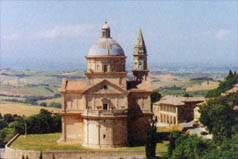 This is the largest town in the Sienese Valdichiana and contains six other villages: Abbadia di Montepulciano, Acquaviva, Gracciano, Montepulciano Stazione, S.Albino and Valiano. The poet Agnolo Ambrogini (known as "il Poliziano" from the Latin "mons Politianus") was born here. The town is said to have been founded by the Etruscan king Porsenna and exhibits impressive architecture, mainly but not only Renaissance. Michelozzo, Baldassarre Peruzzi and Vignola all worked here, as did Antonio da Sangallo il Vecchio who designed the temple of San Biagio. A part from the wonders of the historical centre of Montepulciano the tourist could visit the spa centre at S.Albino. The local economy is based on agriculture and the town is famous for its Vino Nobile.
This is the largest town in the Sienese Valdichiana and contains six other villages: Abbadia di Montepulciano, Acquaviva, Gracciano, Montepulciano Stazione, S.Albino and Valiano. The poet Agnolo Ambrogini (known as "il Poliziano" from the Latin "mons Politianus") was born here. The town is said to have been founded by the Etruscan king Porsenna and exhibits impressive architecture, mainly but not only Renaissance. Michelozzo, Baldassarre Peruzzi and Vignola all worked here, as did Antonio da Sangallo il Vecchio who designed the temple of San Biagio. A part from the wonders of the historical centre of Montepulciano the tourist could visit the spa centre at S.Albino. The local economy is based on agriculture and the town is famous for its Vino Nobile.
In the summer the town hosts the "Cantiere Internazionale d'arte" and in the mid-Augut holidays the "Bruscello", a traditional show spoken in rhyme, is performed on the Cathedral steps. On August 29 a wine barrel race, the "Brav�o", is run between the different � contrade�, or districts, of the town and there is a procession in 13th-century dress.
CHIANCIANO
TERME
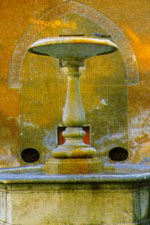 This spa town, which is highly qualified in the treatment of liver disorders, is among the most famous in Italy. The special properties of the waters of Chianciano is not far from the spa centre with its hotels, shops, treatment centres and elegant parks where the therapeutic waters emerge: "acqua Sillene" is used for bath therapy and mud-bath treatment; acqua Sant'Elena" used for the treatment of kidneys and urinary disorders. Both the climate and the unspoilt green areas are excellent, holidays here are fulfilling and pleasant and dedicated to health and fitness. This spa town, which is highly qualified in the treatment of liver disorders, is among the most famous in Italy. The special properties of the waters of Chianciano is not far from the spa centre with its hotels, shops, treatment centres and elegant parks where the therapeutic waters emerge: "acqua Sillene" is used for bath therapy and mud-bath treatment; acqua Sant'Elena" used for the treatment of kidneys and urinary disorders. Both the climate and the unspoilt green areas are excellent, holidays here are fulfilling and pleasant and dedicated to health and fitness.
More than 2 million people visit Chianciano every year. Cultural attractions include the Museo Etrusco, soon to be opened, and the Museo della Collegiata. Also to be seen are the Collegiata church of S.Giovanni Battista, built in 1229 and restored in 1809, the church of the Compagnia (1517), the Torre dell'Orologio with Medici crest and the church of Madonna della Rosa (1585) designed by B. Lanci.
CHIUSI
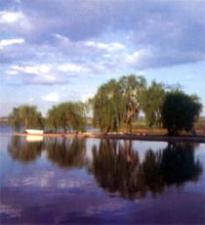 In Etruscan times, on the southern edge of the Valdichiana, stood the town of Chamars, powerful enough, in that period, to defeat Rome. In the historical centre, with its medieval architecture as well as styles of the Granduchy, remains of the Roman structure, which were built on the top of the pre-existing Etruscan town, can still be seen. In Etruscan times, on the southern edge of the Valdichiana, stood the town of Chamars, powerful enough, in that period, to defeat Rome. In the historical centre, with its medieval architecture as well as styles of the Granduchy, remains of the Roman structure, which were built on the top of the pre-existing Etruscan town, can still be seen.
The Museo Archeologico Nazionale contains excellent Etruscan finds and Greek ceramics from the countryside around Chiusi; the funeral urns and sarcophagi are particularly interesting. It is possible to visit the catacombs and Etruscan necropolises; the Tomba del Leone (6th century b.C.) and the Tomba della Pellegrina (5th century b.C.) are open. Definitely worth visiting are the Museo della Cattedrale and the "labirinto di Porsenna", underground water passages built by the Etruscan and including a large cistern which leads to the Romanic cathedral bell tower. There are four neighbouring localities: Macciano, Montallese, Montevenere and Querce al Pino. Festivals: The festival of Santa Mustiola with its palio delle Torri and the September wine festival.
PIENZA
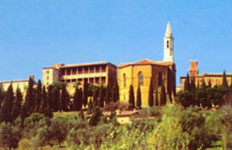 The town stands on the top of a hill which overlooks the splendid Val d'Orcia. Enea Silvio Piccolomini was born here in 1405 and when he became pope Pius II in 1458 he decided to transform his modest village into the perfect town, an admirable example of the humanistic period, and entrusted Bernardo Rossellino with design. Piazza Pio II is intact, incorporating the most rigorous Renaissance perspective, and containing the Cathedral and Palazzo Piccolomini. The town's main axis is Corso Rossellino, lined with houses built by the nobility in the 14th century. The town stands on the top of a hill which overlooks the splendid Val d'Orcia. Enea Silvio Piccolomini was born here in 1405 and when he became pope Pius II in 1458 he decided to transform his modest village into the perfect town, an admirable example of the humanistic period, and entrusted Bernardo Rossellino with design. Piazza Pio II is intact, incorporating the most rigorous Renaissance perspective, and containing the Cathedral and Palazzo Piccolomini. The town's main axis is Corso Rossellino, lined with houses built by the nobility in the 14th century.
Pienza is a mainly agricultural centre, particularly famous for its pecorino cheese. The traditional cheese show, "fiera del cacio" takes place on the first Sunday of September. The flower show "Pienza e i fiori" takes place in mid May. Also to be visited is Monticchiello, made famous by its "Teatro povero", a new play enacted each summer by the local inhabitants.
SAN QUIRICO
(Bagno Vignoni)
 Originally an Etruscan town, it acquired importance thanks to the neighbouring Via Francigena. Federico Barbarossa, in 1154, received the ambassador of Pope Adrian IV here and this event is recalled in the "Festa del Barbarossa", 3� Sunday of June. In 1167 it was seat of the Imperial Vicar. The Florence of Cosimo I de' Medici purchased it in 1559. The Collegiata of SS. Quirico and Giuditta is in the Romanesque style: it has three portals and one on the southernface is attributed toGiovanni Pisano. Inside there is the Polittico of Sano di Pietro and a Chorus from 1432-1502. Palazzo Chigi is from the XVII century. Originally an Etruscan town, it acquired importance thanks to the neighbouring Via Francigena. Federico Barbarossa, in 1154, received the ambassador of Pope Adrian IV here and this event is recalled in the "Festa del Barbarossa", 3� Sunday of June. In 1167 it was seat of the Imperial Vicar. The Florence of Cosimo I de' Medici purchased it in 1559. The Collegiata of SS. Quirico and Giuditta is in the Romanesque style: it has three portals and one on the southernface is attributed toGiovanni Pisano. Inside there is the Polittico of Sano di Pietro and a Chorus from 1432-1502. Palazzo Chigi is from the XVII century.
The "Horti Leonini"(16 th century) are one of the first examples of Italian Garden style: from August to October there is an exhibition of sculpture "Forms in green". The Romanesque parish church of S. Maria Assunta was, perhaps, constructed on the remains of a pre- Cristian temple. The inside of the church of S. Francesco holds two wooden polychrome statues and a Robbia's Madonna. The area of Bagno Vignoni was known about fromRroman times through the benefits of the waters from its spring which gush forth at temperatures of more 50�C. and are gathered in the big basin which lies in the centre of the town and gives it its evocative appearance. There is a small sanctuary dedicated to S. Caterina from Siena situated at the side of the basin. The castle of Vignoni looks down upon the town and can be reached either by S. Quirico or by Bagno Vignoni: a natural walk which can be made on foot.
MONTALCINO
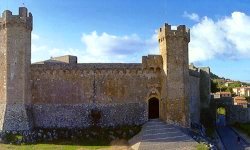 Without doubt, Montalcino lives a life of many souls. Montalcino as the birthplace of Brunello wine, which someone once defined as the best and most renowned wine in Italy. From the height of its 564 m. the ancient town dominates the surrounding countryside, clinging to the slopes of a hill crowned by the imposing 14th-century fortress. In the labyrinth of little streets, amongst artisans' shops, small caf�s and places selling typical local products ( besides the wine, their honey and locally-made biscuits called "dead bones" are also well-known) the places worth seeing are the fine Town Hall, the Bishop's Palace ( housing the United Civic, Diocesan and Archaeological Museums, with works Without doubt, Montalcino lives a life of many souls. Montalcino as the birthplace of Brunello wine, which someone once defined as the best and most renowned wine in Italy. From the height of its 564 m. the ancient town dominates the surrounding countryside, clinging to the slopes of a hill crowned by the imposing 14th-century fortress. In the labyrinth of little streets, amongst artisans' shops, small caf�s and places selling typical local products ( besides the wine, their honey and locally-made biscuits called "dead bones" are also well-known) the places worth seeing are the fine Town Hall, the Bishop's Palace ( housing the United Civic, Diocesan and Archaeological Museums, with works
by important 13th-16th century Sienese artists, such as Bartolo di Fredi, Il Sodoma, Bartolomeo Neroni), the antique Crucifix of Saint Antimus dating back to the mid-12th century, and the churches of Saint Augustine, Saint Giles and Saint Francis, all built between the 13th and 14th centuries, as well as the Sanctuary of our Lady of Succour. But it is just a little way out of town, near Castelnuovo dell'Abate in the Starcia valley that thhe heart of Montalcino spirituality is to be found:the Romanesque abbey of St.Antimus, a striking little temple enveloped in an almost magical atmosphere, founded by Charlemagne in 781. Finally, there are several castles on Montalcino land: the one worthy of mention is Poggio alle Mura, which has Longobard origins.
Abbazia di s.Antimo
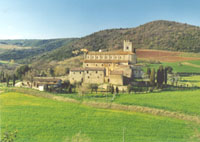 Only 9 km far from Montalcino, one of the most beautiful Romanesque churches in Italy, the Abbey of Sant'Antimo, stands in solitary splendour. According to the legend, it lies on the site of an ancient chapel built to the orders of Charlemagne in 781. In fact, the abbey, an extraordinary example of Romanesque architecture in French-Lombard style, was built in the 12th and 13th centuries by Abbot Azzo dei Porcari. Only 9 km far from Montalcino, one of the most beautiful Romanesque churches in Italy, the Abbey of Sant'Antimo, stands in solitary splendour. According to the legend, it lies on the site of an ancient chapel built to the orders of Charlemagne in 781. In fact, the abbey, an extraordinary example of Romanesque architecture in French-Lombard style, was built in the 12th and 13th centuries by Abbot Azzo dei Porcari.
Abbazia Monte Oliveto maggiore
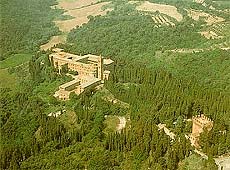 At the centre of the Crete Senesi close to Asciano, there is Monte Oliveto Maggiore. Some of the great gentlemen of Siena's merchants as Giovanni Tolomei and Ambrogio Piccolomini, founded the monastery where they retired here in 1313 to escape the fatal sophistication of the medieval city. The new foundation followed the Benedictine Rule "Ora et Labora" approved by the Pope only six years later.
Monte Oliveto is a marvel of Renaissance clarity and rationality expressed in a simple structure with its 15th-century rose-pink abbey church , a Baroque building with outstanding choir stalls of inlaid wood and the great Cloister,embellished with 36 frescoes of scenes from the life of St.Benedict,begun by Luca Signorelli who completed nine panels while the remaining 27 were finished by Sodoma in 1508 . At the centre of the Crete Senesi close to Asciano, there is Monte Oliveto Maggiore. Some of the great gentlemen of Siena's merchants as Giovanni Tolomei and Ambrogio Piccolomini, founded the monastery where they retired here in 1313 to escape the fatal sophistication of the medieval city. The new foundation followed the Benedictine Rule "Ora et Labora" approved by the Pope only six years later.
Monte Oliveto is a marvel of Renaissance clarity and rationality expressed in a simple structure with its 15th-century rose-pink abbey church , a Baroque building with outstanding choir stalls of inlaid wood and the great Cloister,embellished with 36 frescoes of scenes from the life of St.Benedict,begun by Luca Signorelli who completed nine panels while the remaining 27 were finished by Sodoma in 1508 .
TREQUANDA
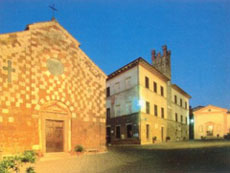 This former medieval hamlet, residence of the Cacciaconti family until the 1500s, stands on the top of a hill, deep in unspoilt countryside of woods, vineyards and olive groves. A third of the village is occupied by the Cacciaconti castle and its annexes including an impressive ornamental garden. Here you can visit the church of SS. Pietro and Andrea which contains a fresco by Sodoma. This former medieval hamlet, residence of the Cacciaconti family until the 1500s, stands on the top of a hill, deep in unspoilt countryside of woods, vineyards and olive groves. A third of the village is occupied by the Cacciaconti castle and its annexes including an impressive ornamental garden. Here you can visit the church of SS. Pietro and Andrea which contains a fresco by Sodoma.
The mild climate, the relaxing countryside and the gastronomic attractions (wine, oil, cheese, salami, honey and local "chianina" beef) make the area a popular destination for farm holidays. The town hall buildings in Petroio house the "terracotta association" and the terracotta museum is now being prepared. The pottery or "coccio", produced by the local manufacturing is famous throughout Italy. Castelmuzio stands on a outcrop of tufa close to the monastery of S. Anna in Camprena which contains remarkable frescoes by Sodoma; the parish church of S. Stefano is also nearby.
Situa
SIENA
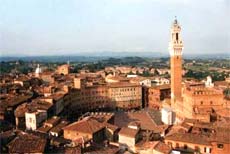 Situated 322 m. above sea level in the heart of Tuscany, this town is built on three hills, maintaining intact its medieval appearance characterized by narrow winding streets and noble buildings.
Of Etruscan origin, it was a Roman colony with the name of Sena Julia; its importance grew in the Middle Ages, first as the seat of Lombard gastalds, and then of Counts under the Carolingian domination. After a long period of episcopal dominion (9th-11th century) the town reached a peak of power after becoming a municipality (1147), undertaking a policy of expansion towards the bordering territories. Situated 322 m. above sea level in the heart of Tuscany, this town is built on three hills, maintaining intact its medieval appearance characterized by narrow winding streets and noble buildings.
Of Etruscan origin, it was a Roman colony with the name of Sena Julia; its importance grew in the Middle Ages, first as the seat of Lombard gastalds, and then of Counts under the Carolingian domination. After a long period of episcopal dominion (9th-11th century) the town reached a peak of power after becoming a municipality (1147), undertaking a policy of expansion towards the bordering territories.
Confrontation with Florence was inevitable and the struggle lasted, with various vicissitudes, until 1555, when after a long siege, Siena was conquered by the Florentines, losing its autonomy and becoming part of the Duchy, sharing its fortunes until unification with Italy.
Events: Palio of Contrade (2nd July and 16th August), St. Caterina's Celebration (29th April), Musical Weeks in Siena (September).
O
CORTONA
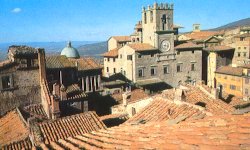 One of the twelve cities of the Etruscan League-substantial fragments of its primitive cyclopean defences can still be seen, incorporated in the medieval walls. Apart from a few fine Renaissance palaces, the prevailing character of Cortona's architecture is medieval, conferring on the steep narrow streets a strong sense of atmosphere. The city is situated in a high position and there are magnificent panoramas, embracing the whole of the Val di Chiana. Prominent among many art works of various periods in the Museo dell'Accademia Etrusca are the Etruscan Chandelier known as the "lamp of Cortona", one of the most celebrated bronzes of antiquity, and the "Polyhymnia Muse", a painting to encaustic of the Roman era, of Remarkable beauty. One of the twelve cities of the Etruscan League-substantial fragments of its primitive cyclopean defences can still be seen, incorporated in the medieval walls. Apart from a few fine Renaissance palaces, the prevailing character of Cortona's architecture is medieval, conferring on the steep narrow streets a strong sense of atmosphere. The city is situated in a high position and there are magnificent panoramas, embracing the whole of the Val di Chiana. Prominent among many art works of various periods in the Museo dell'Accademia Etrusca are the Etruscan Chandelier known as the "lamp of Cortona", one of the most celebrated bronzes of antiquity, and the "Polyhymnia Muse", a painting to encaustic of the Roman era, of Remarkable beauty.
The Museo Diocesano displays works by Luca Signorelli, distinguished Renaissance painter and native of Cortona, and a much-admired "Annunciation" by Beato Angelico.
AREZZO
 Strategically located on a hill at the convergence of the Valdarno ,Casentino and the Valdichiana valleys, ancient Arezzo was one of the richest cities of the Etruscan dodecapolis. It has one of the biggest jewellery industries in Europe and its second most notable industry is furniture-making and antiques marketing. On the first weekend of each month the main square Piazza Grande becomes an enormous antique curiosity shop. Piazza Grande is also the perfect backdrop for the Giostra del Saracino, a celebration of the feats of arms against Saracen pirates who menaced the Tyrrhenian coast, and penetrated inland even as far as Arezzo .
Strategically located on a hill at the convergence of the Valdarno ,Casentino and the Valdichiana valleys, ancient Arezzo was one of the richest cities of the Etruscan dodecapolis. It has one of the biggest jewellery industries in Europe and its second most notable industry is furniture-making and antiques marketing. On the first weekend of each month the main square Piazza Grande becomes an enormous antique curiosity shop. Piazza Grande is also the perfect backdrop for the Giostra del Saracino, a celebration of the feats of arms against Saracen pirates who menaced the Tyrrhenian coast, and penetrated inland even as far as Arezzo .
You can find its typical Christian medieval architecture in the Pieve di S.Maria, with its beautiful rich facade of sculptures going back to the school of Antelami and with the representation to its inside of "La Madonna e i Santi" of Lorenzetti. A careful and laborious job of restoration has given splendour to "La Leggenda della Croce", a group of frescoes by Piero Della Francesca ,preserved inside the Basilica of S.Francesco.
The Church of S.Domenico preserves a beautiful Crocifisso of the Cimabue.
Castiglione de
CASTIGLIONE DEL LAGO
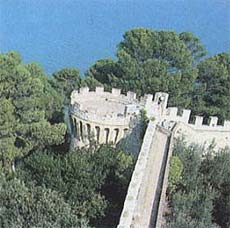 Castiglione del Lago is a fortified city on a small promontory on the west side of Lake Trasimeno. The city is still completely surrounded by the city wall with its original three gates. It is divided into two parts, the inhabited part that goes toward the land and that part which goes toward the lake which has only the Duke�s Palace and a large medieval fortress with its powerful, triangular, 30 m high mast.
The ancient nucleus of Castiglione del Lago has a rectangular design, with Piazza Mazzini as the central axis.
The entire city was set up using geometric and symbolic schemes of medieval urban planning.
Castiglione del Lago is a fortified city on a small promontory on the west side of Lake Trasimeno. The city is still completely surrounded by the city wall with its original three gates. It is divided into two parts, the inhabited part that goes toward the land and that part which goes toward the lake which has only the Duke�s Palace and a large medieval fortress with its powerful, triangular, 30 m high mast.
The ancient nucleus of Castiglione del Lago has a rectangular design, with Piazza Mazzini as the central axis.
The entire city was set up using geometric and symbolic schemes of medieval urban planning.
Towards the piazza, situated at the highest point of the inhabited section, the two main roadways converge. There are three rows of houses along the roads which were originally used by residents and craftsmen. The historical city is a good example of the balance between the houses and the garden areas (which were used for the markets) and the system of roads that united them. Today Castiglione, which is 40 km from both Perugia and Arezzo, is a tourist centre with a large inland area where new housing has developed. There is a well developed area around the lake where the perimeter of the promontory is lined with pine trees, fields, sandy beaches and cliffs. The current population of the communal territory is 13,500 inhabitants.
|



















